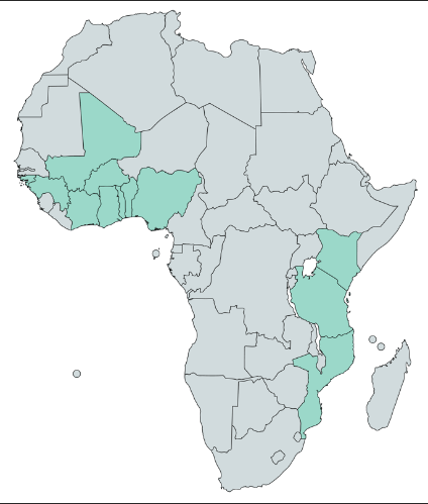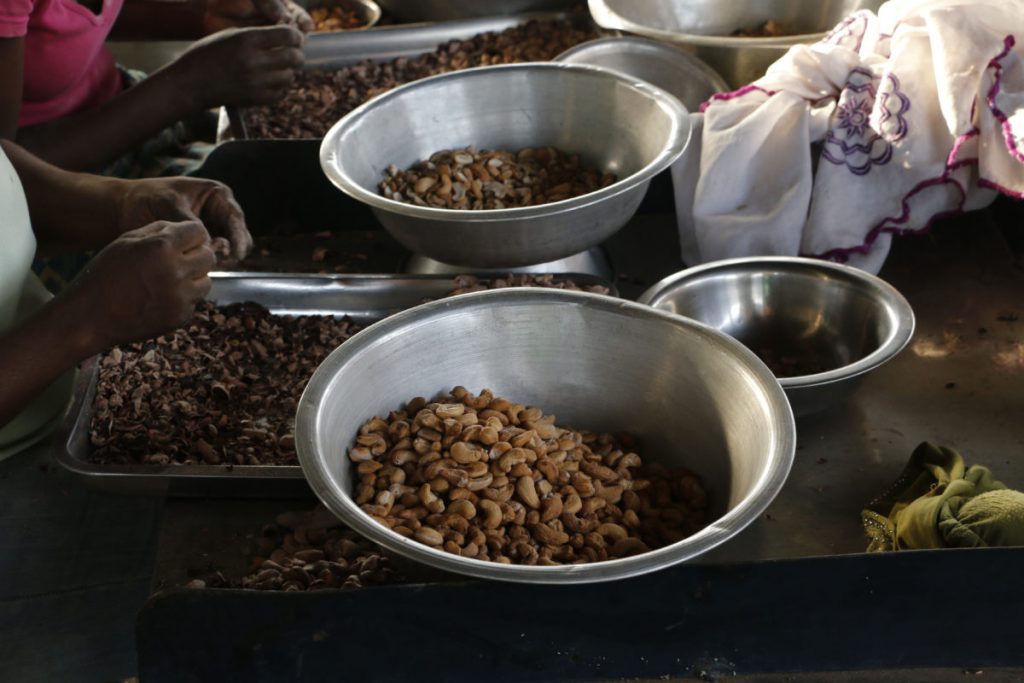Cashew nuts are edible kidney-shaped nuts, rich in oil and protein. They are roasted and shelled before being eaten. The oil extracted from the shells is used as a lubricant, in the production of plastics for example.
Cashew nuts are cultivated in West and East Africa. In West Africa, there are 3 main areas of production: The central area –Côte d’Ivoire, Ghana, Burkina Faso, Guinea, Mali, and Togo– the Eastern area –Nigeria and Benin– and the Western area –Guinea Bissau, Senegal, and The Gambia–. On the East coast of Africa, Tanzania and Mozambique are the major players.

The production & exports
Côte d’Ivoire’s production (800’000 tons) represents around 40% of Africa’s total production. Benin, Tanzania & Guinea Bissau around 10% each. Today Africa produces more than 50% of raw cashew nuts in the world, totalizing over 1’800’000 Tons. About 90% of African production is exported, mainly to Vietnam and India. These two countries account for 98% of the world’s raw cashew imports. This commodity is traditionally exported in bags using 40’HC containers.
In Vietnam and India, cashew nuts are shelled and processed, and then re-exported to the United States, Europe, Middle East, China, and Australia, where they are roasted, salted, and packed for consumption. Value addition is even more important in Europe and North America, where 60% of traded almonds are roasted, salted, packaged, and consumed as a snack.
Asia is the second main production area with India (675’000 Tons) and Vietnam (450’000 Tons) leading the production. Brazil and Indonesia are smaller production areas but have a competitive advantage due to their harvesting calendar which runs from October to December whereas the Northern Hemisphere harvests take place between January and June.

The ups and downs in the cashew nuts commerce
The cultivated cashew nut area in Africa has increased in the last years and represented approx. 4.7 million hectares in 2019. The global cashew industry has grown rapidly during the last years and consumption around the world has increased as well. The raw cashew market previsions estimate that the annual growth rate will be around 4.5% in the next 4-5 years, it is expected to reach US$7 billion by 2025.
The COVID pandemic has affected the cashew market; prices of raw cashews who were already under pressure due to excess supply in the last years got further affected as many processing plants were slowed or closed due to lockdowns and delays in the global supply chain reduced consumer’s demand and dampened the market.
However, the growing demand for cashew nuts worldwide, especially in developed and emerging economies is expected to continue. Driven by several factors, like the recognition of the cashew’s health and nutritional benefits and the growth of plant-based diets. Cashews are also considered a good substitute for dairy products and peanut butter.

At ACS Africa Container Shipping we are ready for this season and are here to assist you with your cashew nut exports from Africa together with our branch offices in Abidjan, Dakar, and our partners in different African production countries.
Don’t hesitate to contact us with any questions or more information!
We have services from all African ports exporting cashew nuts: Abidjan, Tema, Conakry, Lagos, Lome, Cotonou, Bissau, Dakar, Banjul, Dares Salaam, Nacala, Beira, and to main import ports in Vietnam Haiphong and HoChiMinh and India Tuticorin, Vizag (Vishakhapatnam), Chennai, and many more.







